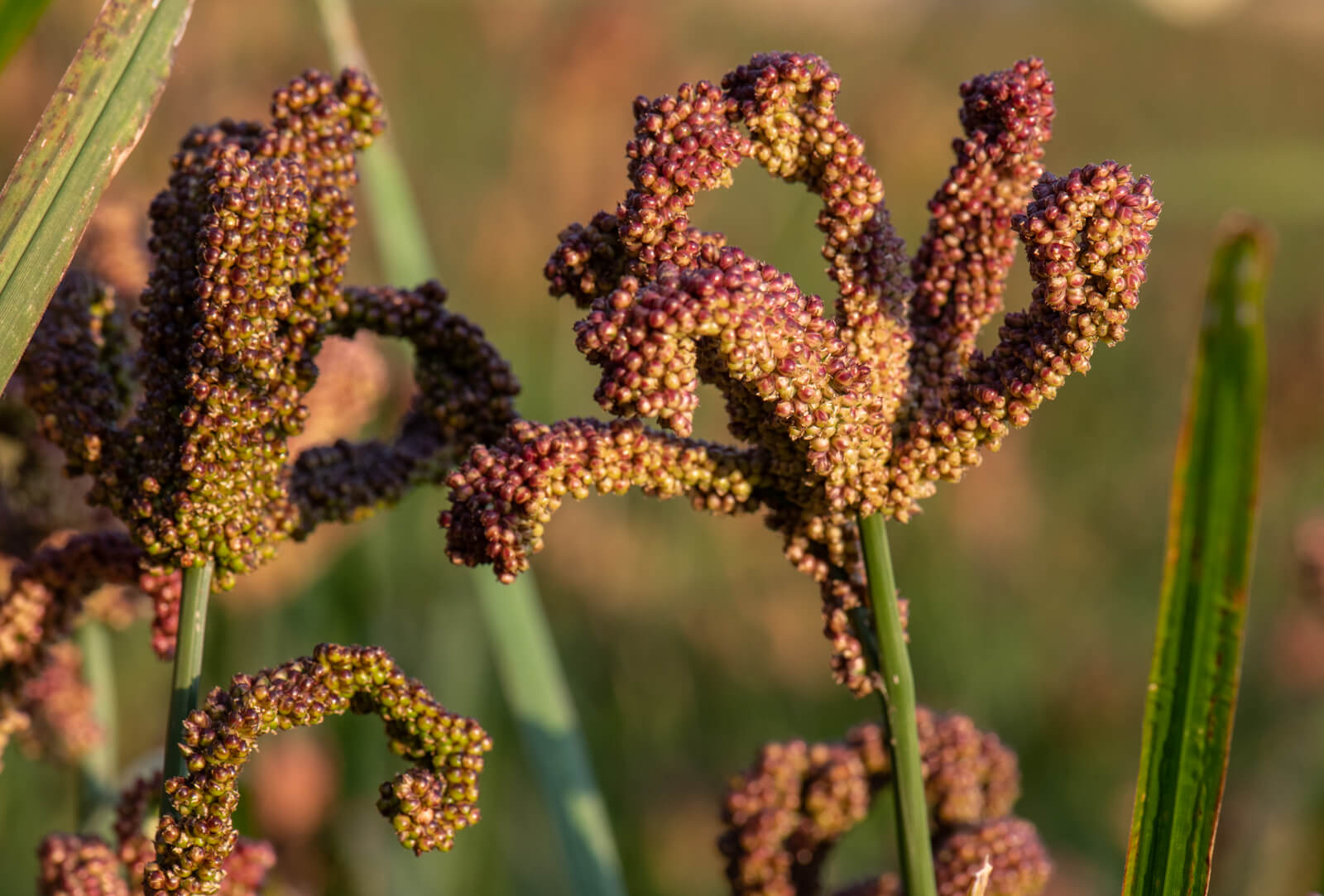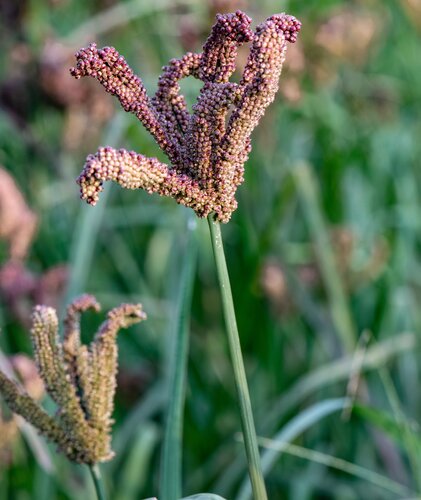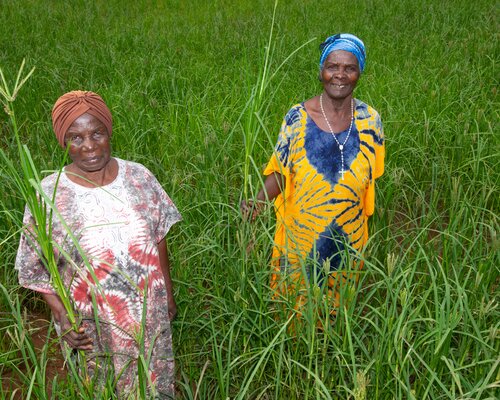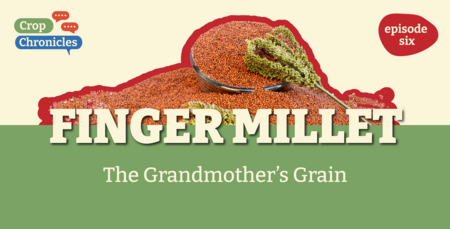Finger millet
Eleusine coracana
Crop Overview
Finger millet (Eleusine coracana (L.) Gaertn.) is a resilient, nutrient-rich cereal crop that plays a vital role in food security for millions of people in arid and semi-arid regions of Africa and Asia. Common names include bird’s foot millet and African millet, and it is known as ragi in India, wimbi in East Africa and bulo in Ethiopia.
The crop is believed to have originated in the highlands of East Africa, particularly in Ethiopia and Uganda, about 5,000 years ago. It spread to India and parts of Southeast Asia around 3,000 years ago and became an integral part of their agricultural and cultural landscapes. Today, finger millet is primarily cultivated in Africa and South Asia, notably in Uganda, Ethiopia, Kenya, India and Nepal. Finger millet’s resilience to drought and ability to thrive on marginal land make it a critical staple in regions facing food security challenges.
Characteristics, Cultivation and Agricultural Practices
Finger millet is an annual cereal that is drought tolerant, adapted to low-fertility soils and resistant to a wide range of pests and diseases, including in storage. This makes it a useful crop for small-scale farmers in areas facing increasingly erratic rainfall and where storage facilities are limited.
The crop is grown on a total of about 4 million hectares worldwide, compared with 9.5 million hectares of oats and 47 million hectares of barley in 2022 (FAOSTAT). Total grain yield in 2022 was estimated at about 3.7 million tonnes. The largest producer is India, followed by Ethiopia and Nepal. Global average yield is about 1 tonne per hectare, although yields of up to 8 tonnes per hectare have been achieved under optimal conditions.
Finger millet is commonly grown in mixed cropping systems with legumes or other cereals, which enhances soil health and supports sustainable farming practices. In many areas, traditional low-input agricultural practices are used, as the crop requires little fertilizer and pesticide.
Nutritional, Economic and Medicinal Value
Finger millet is high in calcium, zinc, iron, dietary fiber and protein, including essential amino acids. It is also rich in minerals, particularly calcium, iron and zinc, and has high fiber content and a low glycemic index, making it ideal for diabetics and people seeking improved digestive health. Finger millet is naturally gluten-free.
These nutritional characteristics make finger millet an excellent food for people young and old, from weaning children and pregnant and nursing mothers to those suffering from diabetes and coeliac disease. It is appealing to people with gluten sensitivities.
The grain is used to prepare a variety of traditional dishes, such as porridge, flatbread and fermented foods. It is also used to produce alcoholic and non-alcoholic beverages in several African countries, and finger millet malt is used in India to prepare nutritious drinks for infants.
The stalks and leaves of the plant are important sources of feed for cattle and small ruminants and the grain as feed for poultry.
Cultural Importance
Finger millet is often involved in rituals, festivals and rites of passage in African and Indian communities. For instance, in parts of Africa, it is customary to include finger millet in offerings to ancestors or deities and to prepare ceremonial foods from it during important cultural events. Its long-standing cultural value contributes to its enduring status as a “heritage grain” in many societies.
Gender Perspectives
Women are central in the cultivation, harvesting and processing of finger millet, particularly in regions where it is the main staple crop. Many women are responsible for such labor-intensive tasks as planting, weeding and threshing, giving them substantial control over its production and, subsequently, its use in household nutrition and food security. However, women often lack access to improved seeds, training and markets, which can hinder their productivity and income from finger millet cultivation.
The crop’s ease of cultivation with minimal inputs can empower women by reducing the labor and resources required. As finger millet becomes more commercially viable, new income opportunities arise for women in value-added processing and marketing. Programs that provide women with access to high-quality seeds, agricultural training and market information can further enhance their role in the finger millet value chain, improving household food security and nutrition.
Why is the Crop Underutilized?
Finger millet faces a number of challenges, including low yield and susceptibility to a range of diseases, such as blast, tar spot and leaf blight. It is also a host for the parasitic weed, Striga hermonthica or witchweed, and pests such as stem borers and fall armyworm. In many markets, the grain is undervalued compared with rice and wheat, partially due to traditional, labor-intensive milling processes. Additionally, limited access to improved seeds and knowledge about optimal cultivation practices hold back productivity.
Efforts are needed to promote finger millet, including development of improved processing technology and markets. These, together with increased awareness of the crop’s nutritional and environmental benefits, could increase demand and incentivize farmers to cultivate it on a larger scale.
Diversity Available in Genesys
As of December 2024, Genesys, the online information platform about plant genetic resources for food and agriculture conserved in genebanks worldwide, lists more than 14,000 samples of finger millet:
- More than half of these are held in the genebank of the International Crops Research Institute for the Semi-Arid Tropics - 7,413 samples.
- The Genetic Resources Research Institute of the Kenya Agricultural and Livestock Research Organization holds nearly 3,000 samples.
- More than 10,000 of the samples are traditional cultivars or landraces.
Current Breeding Efforts
Breeding programs for finger millet are underway in international and national research institutions in India, various African countries, Nepal and Sri Lanka. These include the Indian Council for Agricultural Research, the Kenya Agricultural & Livestock Research Organization, the National Semi-Arid Resources Research Institute in Uganda, the Ethiopian Institute of Agricultural Research and ICRISAT.
Breeding objectives include increased yields, disease resistance and drought tolerance and higher levels of essential nutrients, such as iron and calcium, to better address malnutrition.
Resources







